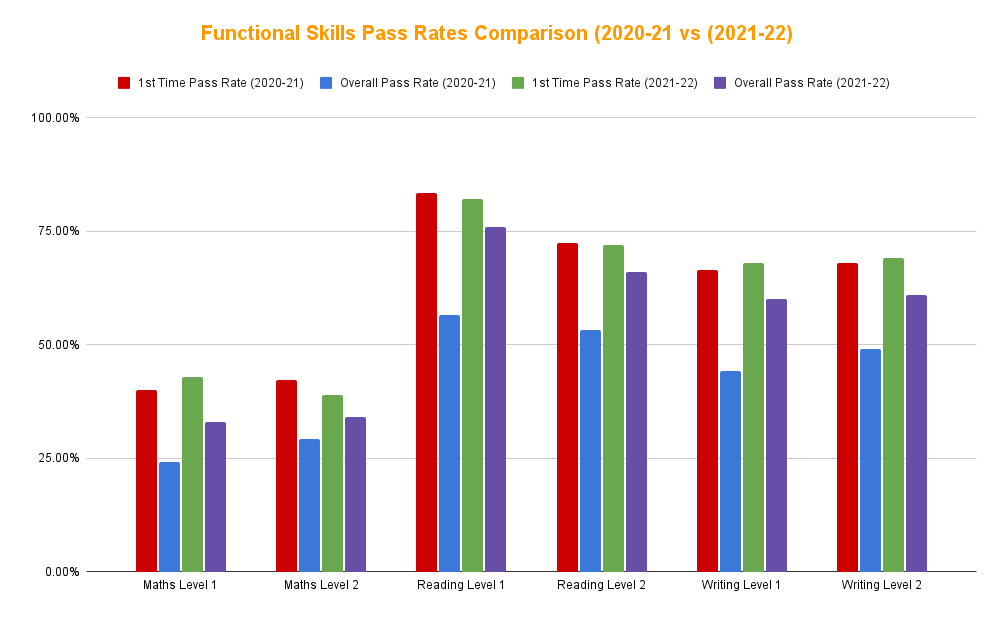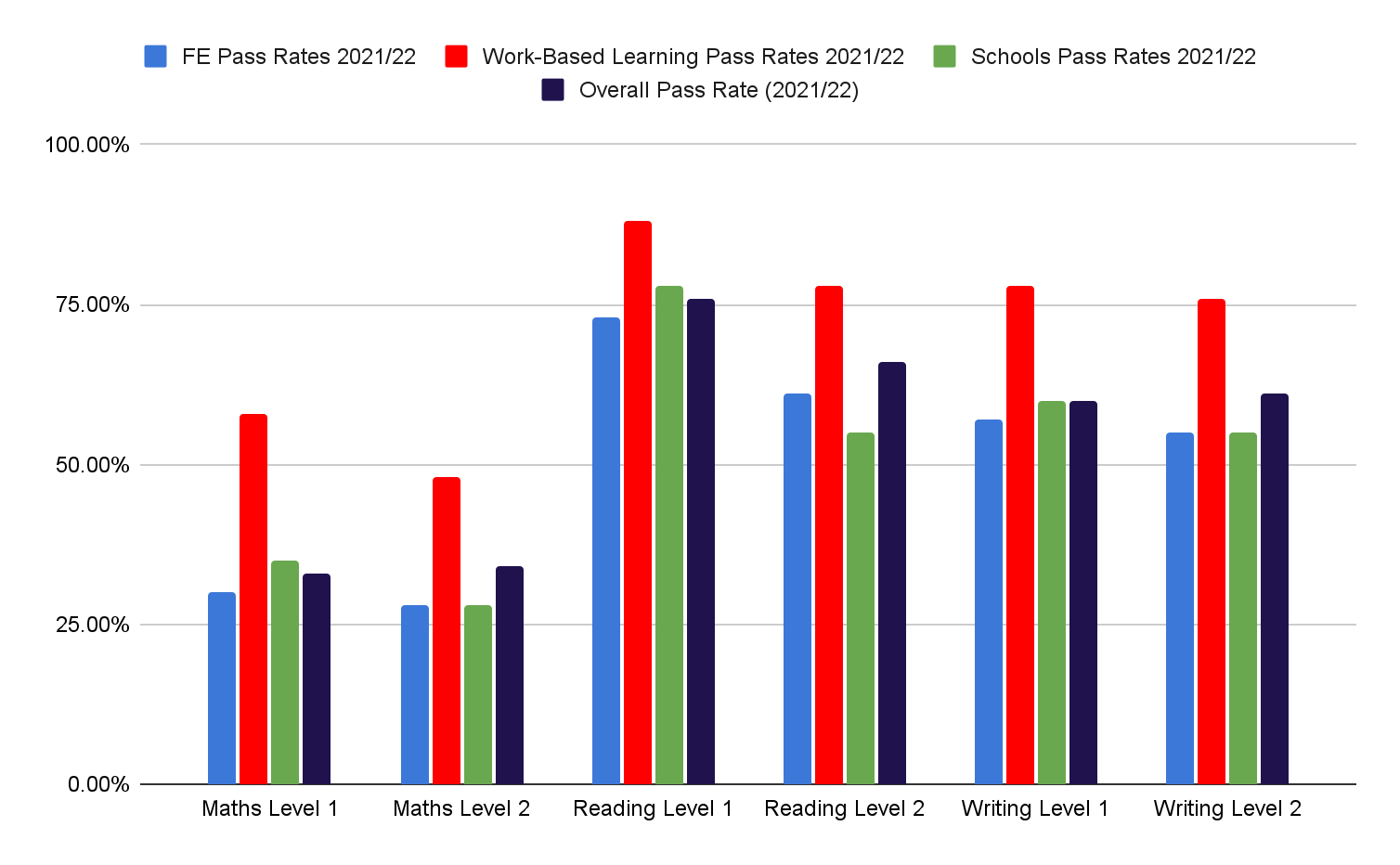Functional Skills
Functional Skills Pass Rates – Comprehensive Analysis Update
Functional skills pass rates provide us with an overview of the current condition of the students related to the Functional Skills subjects. Functional Skills tests are graded as a ‘pass’ or a ‘fail.’ These qualifications have no proxies or portfolio elements.
They are categorised into 5 distinctive Levels where all Entry Level examinations are conducted on paper. They are evaluated internally and moderated by the centre.
In this write-up, we will be analysing the datasheet of 2021/22 from Pearson to evaluate the Functional Skills pass rates of-
- Maths
- English
- ICT
Furthermore, we will explore the average marking times for Pearson’s Functional Skills assessments.
So, let’s get started without further ado.
Before moving on to the flowchart of Maths, English and ICT pass rates, we will first discuss the current condition of the students, what adaptations Pearson has made to increase pass rates, how they work out pass rates, etc.
Table of Content
Adjustments Made to Improve the Pass Rate
The pass rates for Functional Skills show a more gradual return to normalcy following the pandemic crisis in 2021/22. A few adaptations have brought a significant change here, such as-
- Remote invigilation
- Employer invigilation, and
- A significantly growing usage of online mediums like Zoom and Teams for Speaking, Listening and Communicating
-have become commonplace in Functional Skills, assisting in ensuring that the assessment options meet the needs of the learners. These considerable changes in teaching and learning features have had a favourable influence on pass rates.
How Pearson Measures Pass Rates
According to Pearson, a pass rate is simply the number of tests passed as a percentage of the total number of tests taken. On the other hand, for many providers, it is the volume of passes as a proportion of the total number of learners.
These are not always the same thing, especially when resits are considered. For example, in an extreme case scenario, if a learner takes 100 exams and succeeds on the test no. 100, Pearson will provide a pass rate of 1%, while the provider will provide a pass rate of 100%. Please keep this in mind while you look at pass rates.
 Interested In Taking The Functional Skills Maths Level 2 Online Course?
Interested In Taking The Functional Skills Maths Level 2 Online Course?
Entry Level Assessments and Speaking, Listening and Communicating
Pearson does not provide pass rates for Entry Level students in general or for the
- Speaking,
- Listening,
- and Communicating aspects, in particular,
– because these are all assessed internally. We only see the claims of success for these students, not any other attempts they may have made.

Functional Skills English Level 2
- Accredited Courses
- Tutor Support Included
- 3 Installment Plan at checkout
- 14 Days Money Back Guarantee
Pearson’s Pass Rates 2021/22
Pearson’s overall pass rates are shown below. These are open to all learners (both young people and adults) and are not restricted by age, gender, or provider type.
| Assessment | 1st Time Pass Rate | Overall |
|---|---|---|
| Maths Level 1 | 43% | 33% |
| Maths Level 2 | 39% | 34% |
| Reading Level 1 | 82% | 76% |
| Reading Level 2 | 72% | 66% |
| Writing Level 1 | 68% | 60% |
| Writing Level 2 | 69% | 61% |
In the above chart, two things stand out as striking. They are:
- The disparity between the first-time pass rate and the total pass rate is significantly lower than the previous year: 2020/21 FS Pass Rates. You don’t have to switch tabs, however. We’ll show you a comparison of the 2020-21 data just after a while.
- The disparity in pass rates between functional skills in Maths and functional skills in English persists (see below for more detail on this).
First-Time vs Overall Pass Rates
Even though the discrepancy is significantly less than last year, there is still a problem. For example, if you closely observe the pass rates between 2020/21 and 2021/22, the gap between first-time and overall pass rates in work-based learning is minimal (only 1% for Level 1 Reading, for example).
It is crucial to recognise that many students take examinations more than once or twice and are not always successful. However, the overall pass percentage is lower since students who fail their first attempt also tend to fail their second attempt, according to the data. However, prior to any retest, it is advised that failing students spend time discussing the coverage and range points they struggled with.
English vs Maths Pass Rates
Recent research by Ofqual examined the relative difficulty of Maths for Functional Skills across Awarding Organisations and from Legacy to Reformed. This study is accessible here: Reformed functional skills mathematics: evaluation of difficulty.
This study has dealt with the below-mentioned issue. Let’s focus on that.
Why do Students Generally Receive Lower Grades in Maths Than in English?
The vastness of the curriculum and the learners’ starting points are more of a problem than the questions’ difficulty level. The main distinction between Maths and English is the knowledge and skills required to succeed in the assessment.
For instance, the texts essentially include all the information in a reading test. The students only need to use those in their responses. But students need to know more about Maths. For instance, the learners cannot access the question because they do not know how to calculate surface area.
The ability to solve problems is the other significant topic that has gained attention this year. Problem-solving makes up 75% of the marks in Maths for functional skills but only 20% of the marks in GCSE Maths. To succeed, younger learners, in particular, must concentrate on developing their problem-solving abilities.
Pass Rates for 2020–21 and 2021–22

The pass rates for 2020–21 and 2021–22 are shown in the graph above. Fortunately, we can observe that the pass rates have increased across the board. This should indicate that the updated requirements have begun to take effect everywhere, though this increase is less in Maths than in English.
Top Courses of this Category
Difference Between Onscreen and Paper-Based Pass Rates
Though they are marginally higher for onscreen tests at Level 2, there is generally a minimal distinction between pass rates for onscreen and paper-based exams. Therefore, it’s more important to consider the age of the test-takers than the accessibility of the tests.
As you can see below, the majority of onscreen exams are administered during work-based learning, when learners’ pass rates are noticeably higher than the norm. Typically, these learners are older than those in other programs.
Pass Rates by Provider Type

We observe that the providers who offer work-based learning continue to perform better than both schools and FE (Further Education) colleges. There are several causes for this:
Learner Age
Twenty-four years or older students have a much better success rate with functional skills. This is sometimes because of the testing style, but more frequently, it is because of the learners’ motivation and experience. It’s interesting to note that the pass rate for Level 1 Maths in FE colleges is roughly 60% for students aged 24 and up. In addition, a higher proportion of learners in the 24+ group participate in work-based learning.
Many 16-year-olds have little to no experience taking live assessments and haven’t taken one since their SATs. This may have had an impact on the results in some way. For example, most 16-year-olds enrolled in Functional Skills are in FE.
Learners’ Motivation
Within FE, Functional Skills are a required component of the training program for learners on an apprenticeship programme (where appropriate). The main distinction is that students must pass their English and Maths in order to complete their apprenticeship, which motivates them to succeed.
Condition of Funding
Providers can select the best Maths and English courses for their students since there are no financing restrictions for those enrolled in work-based learning. This indicates that more learners with grade 3 GCSE English and Maths are pursuing Level 2 Functional Skills qualifications.
TAGs
Teacher Assessed Grades (TAGs) have significantly impacted functional skills pass rates. However, due to a generous teacher-assessed grade, many FE students must sit for Functional Skill exams higher than in previous years.
Loss of Learning
Younger students still have trouble catching up on the knowledge lost during the COVID lockdown years. So for many years to come, we will need to provide help for students with this.
FE Pass Rates 2021/22
The table below displays the functional skills pass rates for FE.
| Assessment | 1st Time Pass Rate | Overall |
|---|---|---|
| Maths Level 1 | 40% | 30% |
| Maths Level 2 | 33% | 28% |
| Reading Level 1 | 81% | 73% |
| Reading Level 2 | 69% | 61% |
| Writing Level 1 | 67% | 57% |
| Writing Level 2 | 64% | 55% |
Work-Based Learning Pass Rates 2021/22
The table below displays the functional skills pass rates for WBL.
| Assessment | 1st Time Pass Rate | Overall |
|---|---|---|
| Maths Level 1 | 63% | 58% |
| Maths Level 2 | 50% | 48% |
| Reading Level 1 | 89% | 88% |
| Reading Level 2 | 79% | 78% |
| Writing Level 1 | 81% | 78% |
| Writing Level 2 | 79% | 76% |
ICT Pass Rates
You are probably wondering right now where the ICT pass rates for 2021/2022 are. Don’t worry. In the section below, we will present a table of ICT pass rates. But ultimately, the justification for disclosing the ICT pass rates at the end is that there isn’t a significant difference between the first-time and overall pass rates. Now, let’s explore the general state of the functional skills ICT pass rates here.
| Assessment | 1st Time Pass Rate | Overall |
|---|---|---|
| Level 1 | 34% | 37% |
| Level 2 | 58% | 55% |
Pearson’s Functional Skills Marking Times 2021/22
For the academic year 2021–2022, Pearson conducted a thorough review of the marking times for Functional Skills:
There are three types of assessments here. They are provided below with their respective number of working days.
- Overall Average (11 days)
- Onscreen (8 days)
- Paper-Based assessment (12/13 days)
FAQ
What is the meaning of Functional Skills?
Functional skills are practical skills in English, Mathematics, and Information and Communication Technology (ICT) that enable people to function confidently, productively, and independently in their daily lives and work.
What grade is a pass in Functional Skills Maths?
This varies from exam to exam and from exam board to exam board, but the passing grade for the level 2 Maths exam is usually approximately 55%, and the same goes for English reading and writing.
Are Functional Skills harder than GCSE?
Every year, many people fail to pass GCSE maths and English. However, some people are unaware that there is an option for GCSE that can be more suitable for them. Functional Skills credentials are comparable to GCSEs. They may be easier for people with difficulty with Arithmetic and English.
How many times can you resit Functional Skills?
Learners can retake the tests as many times as necessary. For Levels 1 and 2, you must create a new entry each time.
Conclusion
The Functional Skills pass rates shown above demonstrate a significant improvement over the years of Reformed Functional Skills, possibly marking the beginning of an upward trend. Hopefully, improvisations of all kinds will help these rates move in the right direction. Furthermore, thorough study, review, and practice can significantly contribute to higher pass rates.
What to Read Next:
- Functional Skills English Level 2 Writing Sample Answers
- Can You Go to University with Functional Skills?
- Essential Functional Skills Booklist for Study and Practice
- What is NVQ Level 3 Equivalent to – Qualification and Equivalent Degree
- What is Functional Skills Qualification? All You Need to Know About This
- What is Pearson Functional Skills?
- How to Become a Functional Skills Teacher – Step by Step Guide









